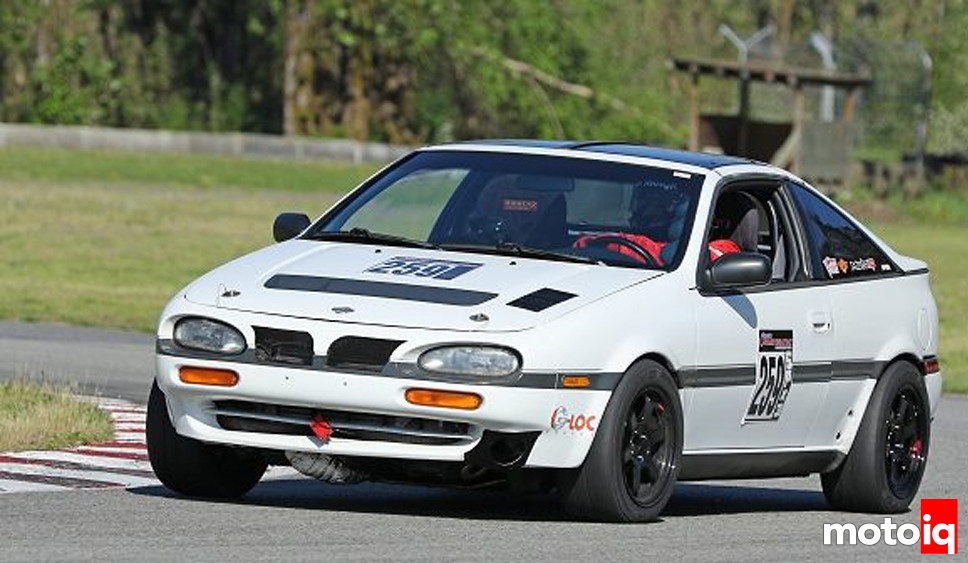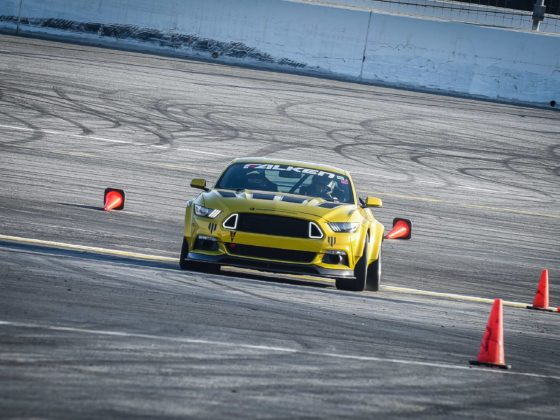 The NX GTi-R has been through tech and is all ready for the Knox Mountain Hill Climb. Tires for the day are Toyo RRs – two groove tires that offer outstanding traction. The day park at the bottom of the hill, on the shores of the Okanagan Lake, is incredibly scenic. While it may not be ideal for wrenching on a car, it is incredibly relaxing. After all, you are in a park in one of the most beautiful locales in North America.
The NX GTi-R has been through tech and is all ready for the Knox Mountain Hill Climb. Tires for the day are Toyo RRs – two groove tires that offer outstanding traction. The day park at the bottom of the hill, on the shores of the Okanagan Lake, is incredibly scenic. While it may not be ideal for wrenching on a car, it is incredibly relaxing. After all, you are in a park in one of the most beautiful locales in North America.With the Precision 5128 turbo now pulling very sweetly throughout the powerband, with the boost bumped up a bit more than last year, I have to remember that this is not an endurance racer but a true time attack car. Run the hot laps and then pull off the track. The heat has been controlled but, I have to admit, not fully contained. Of course, I’m not sure that many turbo cars have the heat fully contained!

The zip ties have been replaced with proper metal brackets and bolts. This was used for test fitting the fan.
First of all, a necessary recap of the NX GTi-R. It started out life as a Nissan NX1600 that I bought new at the end of December 1992. I ran it stock for several years and then started upgrading the suspension and added virtually every bolt on available for the GA16 engine. My daughter and I raced it quite successfully with Ontario Time Attack where, to my knowledge, it still holds a class record or two.
Then the swap to the 54c SR20DET and ran it like that for about two years. Then the SR was built with Eagle Rods, CP Carrillo pistons, JWT cams, and a Precision turbocharger. Also included in the build was a Cometic head gasket, Calico coated bearings, ARP head studs, Ishihara-Johnson crank scraper, and a host of OEM goodies from GSpec like new water and oil pumps.
The car also has a Nismo LSD in the B15 five-speed transmission. This past winter saw the addition of a range of HeatShield Products and the installation of a Koyorad aluminum racing radiator. In the engine, I run Amsoil 15-50 synthetic and in the transmission, I run Amsoil Severe Gear 250. That is a quick overview of the past twenty-six years.
Now it is time to discuss the heat. In 2017 at Knox Mountain every run was bordering on if not right on the maximum temperatures that my comfort would allow. In 2018 my first run the water temperature was just touching 98° Celcius. That is 7° Celcius lower than any run at any speed from 2017. My second run the temperature as about 102° Celcius. Again, a noted improvement. That in itself is enough to show that the HeatShield Products and the Koyorad were invaluable upgrades. Now let’s look at the numbers.
 Koyorad products are built in ISO 9001 factories. Even better, all of the production takes place in factories owned by Koyorad. The quality is evident in every aspect of the build.
Koyorad products are built in ISO 9001 factories. Even better, all of the production takes place in factories owned by Koyorad. The quality is evident in every aspect of the build.Water Temperature readings come from my Stewart Warner Maximum gauges. In 2017 were taken in the fall and they were 105° Celcius – the gauge sensor located right in the top of the radiator. At Knox Mountain in 2017, they got even higher than 105°C. In 2018 the gauge sensor is located in the pipe run from the head to the Koyorad. Theoretically, this should be a slightly higher reading than the previous location.
The temperature reading at the top of Knox after the first run was 97-98°C. Absolutely perfect. The first run in 2017 was almost 10° higher. The second run of 2018 was between 101-102°C and could not be better for a hot lap. At Mission Riversedge Road Course the temperatures did start to close in on 105°C, but that was after nearly twenty minutes on the road course. I do view this as a success.
 The HeatShield Products certainly changes the appearance inside the engine bay. And without a doubt in my mind, I can tell you that they absolutely improve the conditions in the engine bay during track usage.
The HeatShield Products certainly changes the appearance inside the engine bay. And without a doubt in my mind, I can tell you that they absolutely improve the conditions in the engine bay during track usage.The exhaust manifold presented numbers that literally made me do a triple take – because I could not believe what I was seeing. The 86°C temperature was repeated more than once and one of the readings taken in the cool of the early morning actually showed a reading of 73°C. Compared to 464°C we have at least a 378°C difference. Now, this reading is taken from the top of the engine bay and pointed down on to the exhaust manifold. This is where the thickest layer of HeatShield Protection is layered. The bottom of the exhaust manifold is uncovered and allows the heat to radiate downward.



